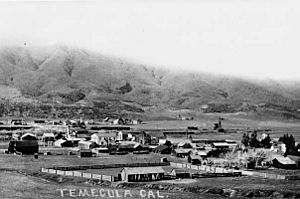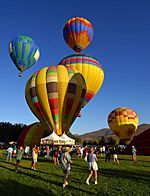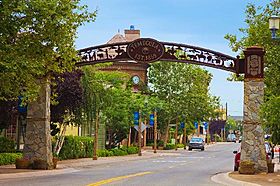Temecula, California facts for kids
Quick facts for kids
Temecula, California
|
||
|---|---|---|
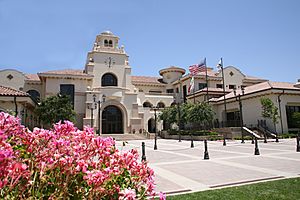
Temecula City Hall
|
||
|
||
| Motto(s):
"Old Traditions, New Opportunities"
|
||
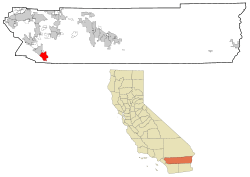
Location of Riverside County within the State of California
|
||
| Country | United States | |
| State | California | |
| County | ||
| Founded | April 22, 1859 | |
| Incorporated | December 1, 1989 | |
| Government | ||
| • Type | Council-manager government | |
| Area | ||
| • City | 37.19 sq mi (96.32 km2) | |
| • Land | 37.18 sq mi (96.30 km2) | |
| • Water | 0.01 sq mi (0.02 km2) 0.03% | |
| Elevation | 1,017 ft (310 m) | |
| Population
(2020)
|
||
| • City | 110,003 | |
| • Estimate
(2022)
|
111,752 | |
| • Rank | 5th in Riverside County 59th in California 272nd in the United States |
|
| • Density | 3,005.70/sq mi (1,160.46/km2) | |
| • Urban | 528,991 (US: 81st) | |
| • Urban density | 3,515.5/sq mi (1,357.3/km2) | |
| Time zone | UTC−8 (Pacific) | |
| • Summer (DST) | UTC−7 (PDT) | |
| ZIP Codes |
92589–92593
|
|
| Area code | 951 | |
| FIPS code | 06-78120 | |
| GNIS feature IDs | 1652799, 2412044 | |
Temecula is a city in southwestern Riverside County, California, United States. The city had about 110,000 people in 2020. It became an official city on December 1, 1989. Temecula is a popular place for tourists. It has the Temecula Valley Wine Country, Old Town Temecula, and fun festivals. There are also golf courses and nice places to stay. All these things help the city's economy.
Temecula is about 58 miles (93 km) north of downtown San Diego. It is also about 85 miles (137 km) southeast of downtown Los Angeles. It is part of the larger Greater Los Angeles area. The city of Murrieta is to the north. The Pechanga Indian Reservation and San Diego County are to the south. Temecula is the main city of the Temecula–Murrieta–Menifee urban area. This area had over 528,000 people in 2020.
Contents
- Temecula's Past: A Journey Through Time
- Where Temecula Is and Its Weather
- People of Temecula: A Growing Community
- Temecula's Economy: What Drives the City
- Fun Things to Do in Temecula
- Sports and Recreation in Temecula
- Learning in Temecula: Schools and Colleges
- Getting Around Temecula: Transportation
- Community Services in Temecula
- Places to Worship
- Temecula's Sister Cities
- Famous People from Temecula
- Images for kids
- See also
Temecula's Past: A Journey Through Time
Early Days: Native Americans and Spanish Explorers
For hundreds of years, the Temecula Indians lived in this area. They are now known as the Luiseños. They were named after the nearby Mission San Luis Rey de Francia. Seven groups of Luiseño Indians lived in the Temecula valley. The Pechanga Band believes their ancestors have been here for over 10,000 years. In their history, life on Earth began in the Temecula Valley. They call it "'Éxva Temeéku," meaning "the place of the union of Sky-father and Earth-mother." The Temecula Indians lived at "Temeekunga," or "the place of the sun." Other ideas for the name include "The sun that shines through the mist."
The first Spanish visit happened in October 1797. A priest named Father Juan Norberto de Santiago came with Captain Pedro Lisalde. Father Santiago wrote in his journal that he saw "Temecula ... an Indian village."
The 1800s: Ranchos, Stagecoaches, and a Famous Book
Not much is known about the early 1800s. Many records were lost in a fire after the 1906 San Francisco earthquake.
In 1798, Spanish missionaries built the Mission of San Luis Rey de Francia. They called the local Indians "Sanluiseños," which became "Luiseños."
Mexican land grants were given in the Temecula area. These included Rancho Temecula and Rancho Pauba. Rancho Little Temecula was given to Pablo Apis, a Luiseño, in 1845. This land was fertile and had good water.
In 1852, a treaty was signed in Temecula. However, the United States Senate never approved it. The Luiseños were later forced to leave their village in 1875.
A stagecoach line started in 1857. It passed through the Temecula Valley. Soon, the Butterfield Overland Mail stagecoach line stopped at Temecula's Magee Store. On April 22, 1859, the first inland post office in Southern California opened here. It was the second post office in the whole state.
In 1862, Louis Wolf, a merchant, married Ramona Place. She was part Native American. Author Helen Hunt Jackson visited them in the 1880s. Wolf's store inspired "Hartsel's store" in her famous 1884 novel, Ramona.
In 1882, the U.S. government created the Pechanga Indian Reservation. It was about 6 miles (9.7 km) from downtown Temecula. Also in 1882, the California Southern Railroad built tracks to Temecula. Floods later washed out the tracks, and the railroad was closed.
By the 1890s, Temecula was known for its granite quarries. The stone was used for fences, curbstones, and buildings. By 1900, Temecula was important for shipping grain and cattle.
The 1900s: Ranching, Growth, and Becoming a City
In 1904, Walter Vail bought ranchland in the Temecula Valley. His family's ranch grew to over 87,500 acres (35,400 ha) by 1947. In 1948, the Vail family built a dam to create Vail Lake. For many years, the Vail Ranch and its cattle business were central to Temecula's economy.
In 1964, the Vail Ranch was sold. The new owners called the area Rancho California.
In 1970, the population of the Temecula area was about 2,769 people. By 1980, it had grown to over 10,000 people.
In 1984, the Temecula Valley AVA was created. This is the official name for the local wine country. The completion of Interstate 15 in 1985 helped more people move to Temecula. They could now live here and still work in San Diego County.
On December 1, 1989, Temecula officially became a city. Ron Parks was its first mayor.
Modern Temecula: Fast Growth and New Features
After 1990, Temecula grew very quickly. Many families moved from San Diego and Los Angeles. They were looking for more affordable homes and enjoyed the wine country.
In 1995, the Pechanga Pow Wow began. This is a big cultural event.
The Promenade Mall opened in 1999. In 2005, Temecula added the Redhawk community, bringing the population to 90,000. After a period of fast growth, the city faced some housing market challenges.
In 2012, the city and the Pechanga tribe stopped a plan for a rock quarry. The tribe bought the land, now called Pu'eska Mountain. In 2013, the Temecula Valley Hospital opened. It provides many hospital services. In 2016, the Vail Headquarters historic district opened. It uses old buildings for shops and restaurants.
Where Temecula Is and Its Weather
Temecula covers about 37.19 square miles (96.32 km2). Most of it is land. South of the city, Murrieta Creek and Temecula Creek join to form the Santa Margarita River.
Temecula's Climate
Temecula has a hot-summer Mediterranean climate. This means it has hot, dry summers and mild, wet winters. August is usually the hottest month. December is the coldest. Most rain falls from November to March. February is the wet wettest month.
In May and June, it's common to have morning fog from the ocean. From July to September, it's hot and dry. Sometimes, there are thunderstorms, but they don't bring much rain. In late fall and winter, dry, windy Santa Ana winds blow. Snow is very rare. A rare F1 tornado touched down in Temecula in 2005.
| Climate data for Temecula, California | |||||||||||||
|---|---|---|---|---|---|---|---|---|---|---|---|---|---|
| Month | Jan | Feb | Mar | Apr | May | Jun | Jul | Aug | Sep | Oct | Nov | Dec | Year |
| Record high °F (°C) | 91 (33) |
95 (35) |
103 (39) |
109 (43) |
109 (43) |
114 (46) |
117 (47) |
118 (48) |
117 (47) |
110 (43) |
98 (37) |
90 (32) |
118 (48) |
| Mean maximum °F (°C) | 79.8 (26.6) |
81.9 (27.7) |
86.4 (30.2) |
92.8 (33.8) |
97.8 (36.6) |
104.8 (40.4) |
108.0 (42.2) |
108.2 (42.3) |
106.0 (41.1) |
98.4 (36.9) |
88.7 (31.5) |
80.9 (27.2) |
110.9 (43.8) |
| Mean daily maximum °F (°C) | 65.3 (18.5) |
66.3 (19.1) |
69.5 (20.8) |
74.1 (23.4) |
81.0 (27.2) |
90.0 (32.2) |
96.7 (35.9) |
97.6 (36.4) |
92.2 (33.4) |
82.5 (28.1) |
73.2 (22.9) |
65.0 (18.3) |
79.5 (26.4) |
| Daily mean °F (°C) | 52.8 (11.6) |
54.0 (12.2) |
57.7 (14.3) |
61.6 (16.4) |
67.8 (19.9) |
74.3 (23.5) |
80.3 (26.8) |
81.3 (27.4) |
77.2 (25.1) |
68.1 (20.1) |
59.0 (15.0) |
52.6 (11.4) |
65.6 (18.6) |
| Mean daily minimum °F (°C) | 40.9 (4.9) |
42.2 (5.7) |
44.4 (6.9) |
47.7 (8.7) |
52.8 (11.6) |
58.3 (14.6) |
64.1 (17.8) |
64.8 (18.2) |
61.2 (16.2) |
52.9 (11.6) |
43.9 (6.6) |
40.5 (4.7) |
51.8 (11.0) |
| Mean minimum °F (°C) | 27.5 (−2.5) |
29.4 (−1.4) |
32.7 (0.4) |
37.2 (2.9) |
43.8 (6.6) |
48.3 (9.1) |
53.8 (12.1) |
55.2 (12.9) |
50.8 (10.4) |
41.4 (5.2) |
34.7 (1.5) |
27.8 (−2.3) |
26.2 (−3.2) |
| Record low °F (°C) | 15 (−9) |
19 (−7) |
24 (−4) |
24 (−4) |
31 (−1) |
35 (2) |
41 (5) |
40 (4) |
35 (2) |
25 (−4) |
20 (−7) |
17 (−8) |
15 (−9) |
| Average precipitation inches (mm) | 3.22 (82) |
3.74 (95) |
2.29 (58) |
.95 (24) |
.35 (8.9) |
.07 (1.8) |
.09 (2.3) |
.05 (1.3) |
.14 (3.6) |
.58 (15) |
.96 (24) |
2.10 (53) |
13.05 (331) |
| Average snowfall inches (cm) | 0.2 (0.51) |
0.0 (0.0) |
0.0 (0.0) |
0.0 (0.0) |
0.0 (0.0) |
0.0 (0.0) |
0.0 (0.0) |
0.0 (0.0) |
0.0 (0.0) |
0.0 (0.0) |
0.0 (0.0) |
0.3 (0.76) |
0.5 (1.27) |
| Source: wrcc.dri.edu | |||||||||||||
People of Temecula: A Growing Community
| Historical population | |||
|---|---|---|---|
| Census | Pop. | %± | |
| 1980 | 1,783 | — | |
| 1990 | 27,099 | 1,419.9% | |
| 2000 | 57,716 | 113.0% | |
| 2010 | 100,097 | 73.4% | |
| 2020 | 110,003 | 9.9% | |
| 2022 (est.) | 111,752 | 11.6% | |
| U.S. Decennial Census | |||
In 2020, Temecula had a population of 110,003 people. The city is made up of many different groups. About 49% of the people were non-Hispanic white. About 11% were Asian American, and 4.4% were Black or African American. About 27.6% of the population were Hispanic or Latino.
In 2010, there were 31,781 households in Temecula. About half of them had children under 18. The average household had 3.15 people. The average family had 3.46 people.
The population has a mix of ages. About 30.7% were under 18. The median age was 33.4 years. This means half the people were younger than 33.4 and half were older.
In 2013–2017, the average household income was $87,115. About 6.8% of the people lived below the poverty line. In 2017, about 32.1% of residents had a bachelor's degree or higher.
Temecula's Economy: What Drives the City
Temecula is a popular place for tourists. This is because of the Temecula Valley Wine Country, Old Town Temecula, and various festivals. There are also championship golf courses and resorts. Other important parts of the economy are education, professional services, finance, and retail.
Major Employers in Temecula
As of 2023, these are some of the biggest employers in Temecula:
| # | Employer | # of Employees |
|---|---|---|
| 1 | Temecula Valley Unified School District | 3,268 |
| 2 | Abbott Laboratories | 1,700 |
| 3 | Temecula Valley Hospital | 1,234 |
| 4 | Milgard Manufacturing Inc. | 530 |
| =5 | Walmart | 500 |
| =5 | Costco Wholesale | 500 |
| 7 | Southwest Traders, Inc. | 484 |
| 8 | Millipore Sigma | 370 |
| 9 | FFF Enterprises | 366 |
| 10 | The Scotts Company | 325 |
Fun Things to Do in Temecula
Wine Country Adventures
The Temecula Valley Wine Country has almost 50 wineries. Many offer wine tasting. The first grapes were planted here in 1967. The wine country is just east of Temecula. The yearly Temecula Valley Balloon & Wine Festival is held at nearby Lake Skinner. It has live music, hot air balloon rides, and wine tasting.
Golfing Fun
There are several golf courses in the area. These include Pechanga's Journey, Redhawk, and Temecula Creek Inn.
Exploring Old Town Temecula
Old Town Temecula is the city's historic downtown. It has old buildings, hotels, and museums. You can find unique shops, restaurants, and antique stores. On Saturdays, Old Town has a farmers' market with many local sellers. Old Town also hosts special events. These include car shows, art festivals, and holiday parades. It's also a lively place at night.
The Temecula Valley Museum is in Old Town. It shows exhibits about local Native Americans and the city's history. The City Hall is also located here.
Old Town has the Old Town Temecula Community Theater. It's a theater with 354 seats. There's also The Merc, a smaller performance space.
Pechanga Resort and Casino
The Pechanga Resort & Casino opened in 2002. It is just outside the city limits. It employs 5,000 people. It is the biggest employer in the Temecula Valley.
Festivals and Events
Temecula hosts many exciting festivals:
- Temecula Bluegrass Festival
- Temecula Valley Balloon & Wine Festival
- Temecula Valley International Film and Music Festival
- Temecula Valley International Jazz Festival
- Temecula Street Painting Festival
- Temecula Greek Festival
- Taste of Temecula Valley
Sports and Recreation in Temecula
Temecula is home to the Temecula Valley Inline Hockey Association (TVIHA). This group offers inline hockey programs for schools and recreation.
The city is also known as the home of the Freestyle Motocross group Metal Mulisha. Members like Brian Deegan live here.
Since 2012, Temecula has had the Wine Town Rollers (WTR) roller derby league.
Temecula has a semi-pro soccer team called Temecula FC.
Boxing and Mixed martial arts fights are held at Pechanga Resort & Casino.
Temecula has 41 parks and 22 miles (35 km) of trails. In 2013, it was named a "Playful City USA." Temecula's Pennypickle's Workshop won an award for "Best Museum" for kids.
Sports parks include the Ronald Reagan Sports Park and the Patricia H. Birdsall Sports Park.
Youth Sports Opportunities
Temecula offers many sports for kids. These include football, cheerleading, roller hockey, wrestling, basketball, baseball, soccer, and lacrosse. The Temecula Mountain Lions Rugby Club started in 2010. It has teams for men, women, and youth.
Learning in Temecula: Schools and Colleges
Public Schools
Public schools in Temecula are run by the Temecula Valley Unified School District (TVUSD). Their schools often have high academic scores in Riverside County. Great Oak, Chaparral, and Temecula Valley high schools have all won awards from U.S. News & World Report.
The school district covers about 148 square miles (380 km2). It has over 28,000 students.
Private Schools
- Concord Lutheran Academy
- Linfield Christian School
- Rancho Christian School
- Saint Jeanne de Lestonnac School
- Van Avery Prep
Charter Schools
- Julian Charter School of Temecula
- River Springs Charter School
- Temecula International Academy
- Temecula Preparatory School
- Temecula Valley Charter School
Higher Education Opportunities
Temecula has Mt. San Jacinto College, which is a public community college. It moved to a larger campus in 2021.
There is also a campus for California State University San Marcos (CSUSM). It offers online courses and special programs. Other colleges with centers in Temecula include National University and University of Redlands. Temecula is also home to Professional Golfers Career College.
Getting Around Temecula: Transportation
Major Highways
Temecula is served by two main highways: Interstate 15 and State Route 79.
Interstate 15 has several exits in Temecula. State Route 79 becomes Temecula Parkway. It then joins Interstate 15 for a short distance. After leaving the freeway, it becomes Winchester Road.
Major roads that go east-west include Murrieta Hot Springs Road and Rancho California Road. Major roads that go north-south include Jefferson Avenue and Butterfield Stage Road.
Public Transportation Options
The Riverside Transit Agency bus system serves Temecula. It has several routes that connect different parts of the city. You can also connect to Greyhound Lines for longer trips.
There was a study in 2005 about extending the Metrolink train line to Temecula. However, this extension was never built.
Airports Near Temecula
The French Valley Airport is located in the Temecula Valley. Temecula is also within 60 miles (97 km) of the Ontario International Airport and San Diego International Airport.
Community Services in Temecula
Cemetery
The Temecula Cemetery is managed by the Temecula Public Cemetery District. The land for the cemetery was given in 1884.
Public Libraries
- Grace Mellman Community Library
- Ronald H. Roberts Temecula Public Library
Places to Worship
Temecula has many places of worship for different religions:
- Calvary Chapel Bible Church
- Chabad of Temecula (Jewish synagogue)
- The Church of Jesus Christ of Latter-day Saints (Mormon)
- The Islamic Center of Temecula Valley
- Reliance Church, built on the site of Temecula's first schoolhouse.
- St. Catherine of Alexandria Catholic Parish, which moved to a larger building. Its old chapel is now part of the Old Town Museum.
Temecula's Sister Cities
 Nakayama-Daisen (Japan; since 1994)
Nakayama-Daisen (Japan; since 1994)
Temecula has a special friendship with Daisen, Tottori in Japan. There is a Japanese Garden at the Temecula Duck Pond to celebrate this friendship.
The Temecula Duck Pond also has an art piece called "Singing in the Rain." It was a gift from the city of Leidschendam-Voorburg in the Netherlands. It honors the strength of the American spirit after the September 11 attacks. The art shows a mother and children riding a bicycle through a storm.
Famous People from Temecula
- Nate Adams, freestyle motocross rider
- Maurice Benard, actor
- Rob Brantly, baseball player
- Allen Craig, former baseball player
- Timmy Curran, professional surfer
- Terrell Davis, retired football player
- Brian Deegan, freestyle motocross rider
- Hailie Deegan, NASCAR driver
- Ronnie Faisst, freestyle motocross rider
- Andy Fraser, musician
- Erle Stanley Gardner, author of Perry Mason novels
- Sarah Hammer, Olympic cyclist
- Christy Hemme, professional wrestler
- Dan Henderson, mixed martial artist
- Reed Johnson, baseball player
- Tori Kelly, singer and songwriter
- Alex Mahan, video game creator
- Cindy Marina, model and Miss Universe Albania 2019
- Margaret Martin, professional bodybuilder
- Sydnee Michaels, LPGA Tour golfer
- Trevi Moran, YouTuber
- Dean Norris, actor from Breaking Bad
- Olivia Rodrigo, actress and singer-songwriter
- Stan Sakai, creator of Usagi Yojimbo
- Jeremy "Twitch" Stenberg, freestyle motocross rider
- Justin Simon, basketball player
- Taylor Tomlinson, comedian
- Mark Towle, car customizer
- Kelsie Whitmore, professional baseball player
- Cassidy Wolf, model and Miss Teen USA 2013
- Xenia, singer
- Jerry Yang, poker player
Images for kids
See also
 In Spanish: Temecula para niños
In Spanish: Temecula para niños




